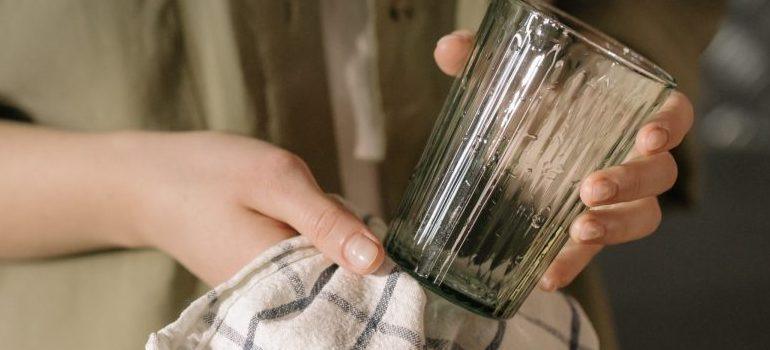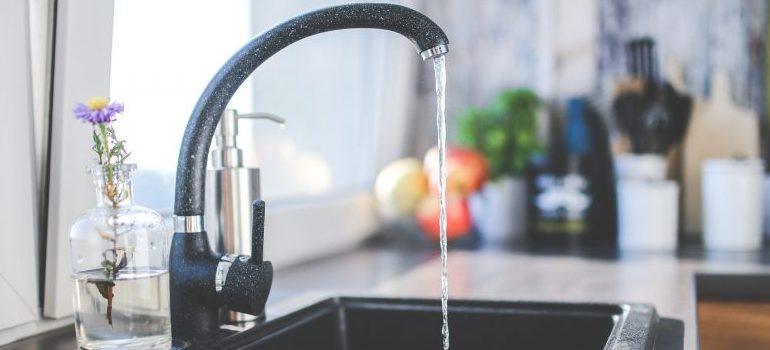When relocating to a new home, the “usual suspects” are whether you should hire movers or do a DIY move, what moving company should you choose for your relocation, etc. But after the entire relocation process is over and you are in your new home, another question presents itself. How to disinfect a new kitchen? The process can be incredibly simple to overwhelmingly complex, depending on the size and layout of your kitchen, but there are some rules that you will want to follow. That is why State to State Move has prepared this article for you, to help you with this process. After reading, you will be able to disinfect your kitchen easily and efficiently!
How to disinfect a new kitchen with ease – Useful tips
Here is what you will need to do, over the course of this process:
- Declutter – get rid of unnecessary, old, and broken dishes and kitchen tools
- Get proper cleaning supplies to disinfect a new kitchen
- Clean the dust from the tops of the cabinets and fridge
- Clean small appliances thoroughly
- Scrub the stove and oven when disinfecting a new kitchen
- Deep clean sink before using it
- Wipe kitchen counters and table
- Leave floors for last!
Do note that there might be specific things in your kitchen that will slightly modify this process. For example, if you have any special equipment, you might want to consult either the cleaning manual or contact cleaning professionals. You can always ask your long distance movers NYC if they know of good service in the area. But for the most part, following the guidelines above will produce great results.

Declutter – get rid of unnecessary, old, and broken dishes and kitchen tools
The first thing you will need to do is figure out what is staying in the kitchen and what is going out. Your new kitchen might have some dishes, kitchen tools, etc. already inside, which might be duplicates of the items you already have. Or you might not even have room for all of your kitchenware, either. In any case, it is important to declutter before starting with the disinfecting effort. Obviously, this is best thought of before you have your long distance movers San Antonio bring in your stuff, as it might cut down on moving costs. Those dishes can get heavy if you have a lot of them. It would be a waste to bring them all the way to your new home and not have a place for them.
Get proper cleaning supplies to disinfect a new kitchen
Once you are certain that your kitchen only contains the necessary items, there is one more thing to do before starting with disinfection. You will need to obtain the cleaning supplies necessary for the process. While decluttering, you will have a good idea of what exactly is in your kitchen, which will make selecting the proper chemicals a lot easier. The best way of obtaining them is to have them delivered to your home but visiting a store is also not a bad idea. You also might want to wait with unpacking after your long-distance move until you have everything disinfected. That way, you can be sure that you are unpacking into a safe environment.
Clean the dust from the tops of the cabinets and fridge
When you start the process, you will want to pay attention to the tops of the fridge and all of the cabinets. These are the places that are often hard to reach and therefore get cleaned far less regularly. This is exactly why you want to start there as those places are most likely in dire need of disinfection. You might need some equipment, like ladders and the like for this, so make sure that you have them ready before you begin.

Clean small appliances thoroughly
If your new kitchen has plenty of small appliances that you’ve decided on keeping, you will want to thoroughly clean them. The best way to do so is to disassemble what you can and clean each part separately. Pay close attention to any blades or parts where food might stick. You will want to apply a bit more disinfectant to these places. Be thorough and careful and you will have no issues.
Scrub the stove and oven when disinfecting a new kitchen
Scrubbing the oven might be one of the most dreaded cleaning tasks in a new kitchen. Especially if you are not the one who made the mess in the first place. This is a prime example where hiring cleaning services might be essential. However, it is not really that difficult when it comes down to it, even if it is a bit icky. Utilize some of the stove-cleaning tips and you will be just fine. Besides, with the cleaning supplies on today’s market, the job is not nearly as hard as it used to be.
Deep clean sink before using it
This is something that you might want to call a handyman for. You will want to start in a fresh environment and you can’t have one without deep cleaning the sink. What you want to do is turn off the water valve and get to work. You will need to get under the sink and remove all that you find there. This is a process that is best left to professionals if you don’t know what you are doing. But if this is not your first proverbial rodeo, you can definitely manage it on your own.

Wipe kitchen counters and table
This might be obvious but in all the other commotion it may get overlooked. The kitchen counters, and the kitchen table, can have a surprising amount of hardened bacteria within them. You are going to need to carefully wipe them with disinfectant, applying considerable pressure. This way, you will be certain that there are none left to threaten you and your family.
Leave floors for last!
A common mistake is to clean the floors first, due to how easy they might be to clean, or how bad they look. But you might want to hold out on this, as you may need to clean them several times if you don’t. It is always better to leave the floors as the last thing to be cleaned and disinfected.
